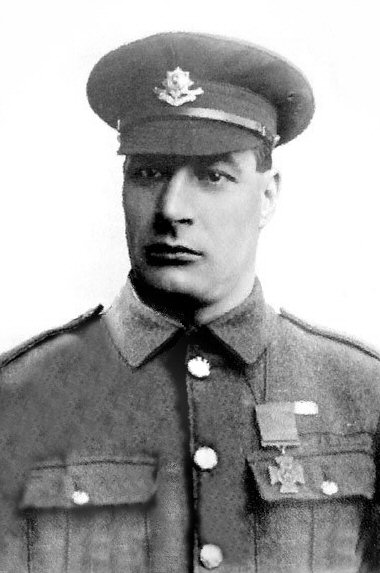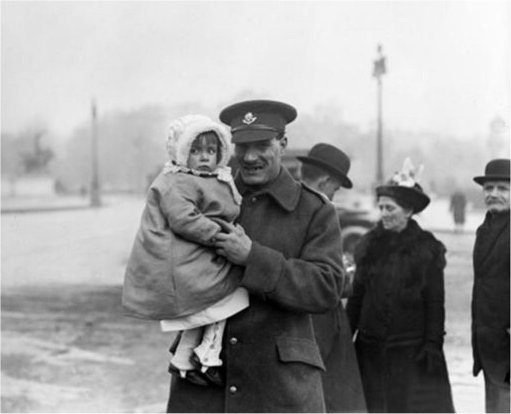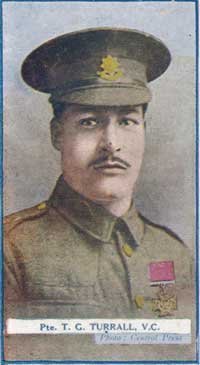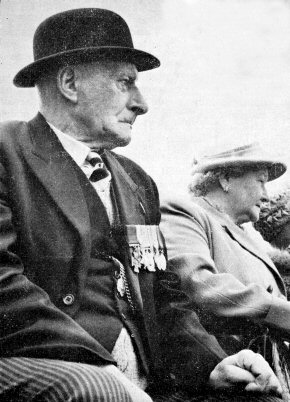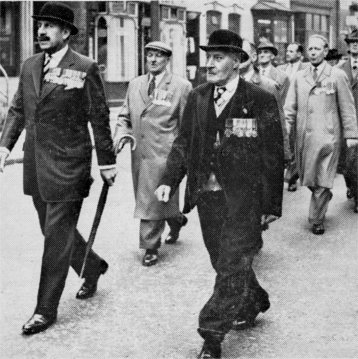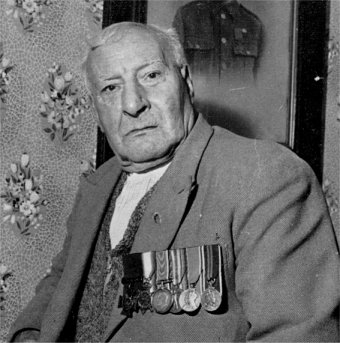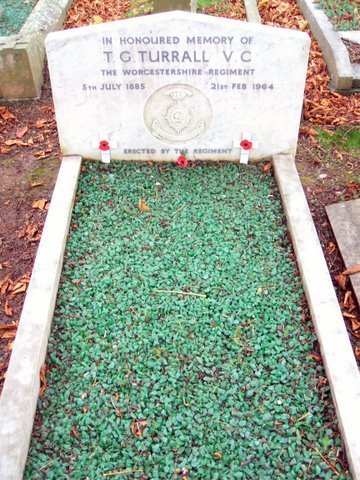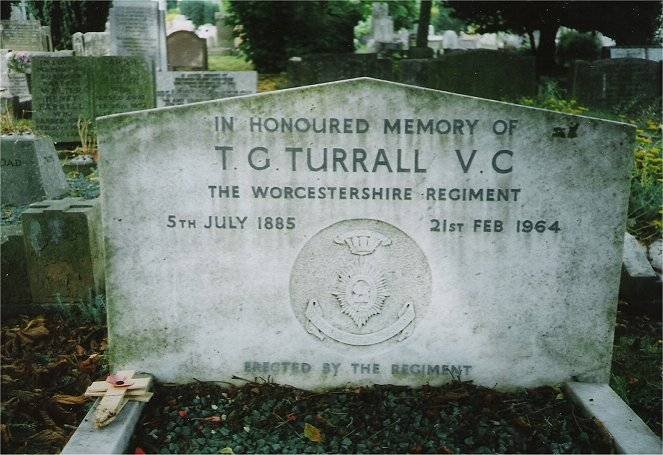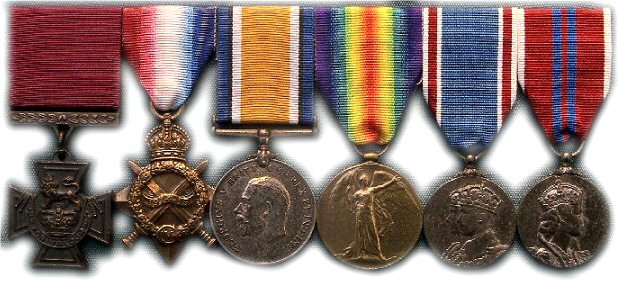Private Thomas George TURRALL V.C. (20572)
Thomas George Turrall was born at Speedwell Road, Hay Mills, Birmingham on 5th July 1886, son of William and Ellen Turrall. Before the war Tom was a painter and decorator, working for the Council, living in Yardley with his wife Mary and his newly born daughter Lilian May. During the winter of 1914 work was becoming difficult so Tom enlisted and joined the Worcestershire Regiment in December 1914. After his initial training he was posted to the 10th Battalion Worcestershire Regiment in France on the 2nd September 1915. Shortly after he arrival in France news reached him that his wife was very ill. He was given compassionate leave to return to be with her for a few days but had to return to France. A fortnight later in Decembe he received the news that Mary, she was just 26 and was buried at Yardley Cemetery on 28th December 1915. Urgent cables had been sent informing Tom Turrall but he was unable to secure leave for the funeral. Tom Turrall was a bomber in 'C' Company and became a well-known character in the Battalion, he had a reputation of been a bit of rebel and was always in trouble! In fact just the week before the action where he won his V.C. he was on a charge for insubordination to an N.C.O. and was held in confinement in the Guard Room in the village where the 10th Battalion were resting behind the front lines (near Dernancourt). This was not the first time that Tom Turrall had been in trouble for his actions. However, his platoon commander Lieutenant Richard William Jennings new that Turrall was a formidable fighter and agreed that Turrall would be released to go into battle that day. Tom Turrall was awarded the Victoria Cross for his bravery at the storming of La Boisselle on the 3rd July 1916. His citation read: "For most conspicuous bravery and devotion to duty. During a bombing attack by a small party against the enemy the officer in charge was badly wounded, and the party having penetrated the position to a great depth was compelled eventually to retire. Private Turrall remained with the wounded officer for three hours, under continuous and very heavy fire from machine guns, and bombs, and, notwithstanding that both himself and the officer were at one time completely cut off from our troops, he held to his ground with determination, and finally carried the.officer into our lines after our counter-attacks had made this possible." (London Gazette 9th September 1916). |
Private Thomas Geroge Turrall V.C. |
Below is an account of the 10th Battalions actions during the storming of La Boisselle and how Private Tom Turrall won his Victoria Cross.
THE STORMING OF LA BOISSELLE (1st to 3rd July 1916)
The IIIrd Army Corps, in the centre of the British battle line, had been entrusted with the capture of the fortresses of Ovillers and Pozieres. On July 1st 1916, the attack of the IIIrd Corps had been partially successful. The 8th Division had failed before Ovillers; on the other hand the 34th Division had bitten deeply into the German positions south of La Boisselle, though that fortified village, despite the explosion of an enormous mine, still defied all assaults. By dawn of July 2nd La Boisselle formed a sharp salient in the enemy's line. A fresh attack was ordered, and the 19th Division were brought forward from Corps Reserve.
The 10th Battalion Worcestershire Regiment, after spending the night before the battle in trenches west of Albert had been moved forward about 9 a.m. on July 1st to assembly positions nearer the line. There the Battalion lay all day amid terrific thunder of gun-fire and conflicting rumours and alarms. After dark (7.40 p.m. according to the Brigade but 9.15 p.m. according to the Battalion) orders came for the 10th Worcestershire and 8th North Staffordshire to move up to the front line for attack. The Battalion moved off. "In the communication trench confusion reigned. Wounded were being brought out—we were trying to get in—carrying parties were trying to go both ways—it was raining and the trench was knee-deep in mud." Not until long after midnight did three companies reach the British front line opposite La Boisselle, and then it was too late for the attack to be carried out. The plan was cancelled, and the three companies made their way back to reserve trenches on the Usna—Tara ridge. By dawn all platoons had been collected in trenches and dugouts. Officers and men alike were utterly exhausted. "The remainder of the day (July 2nd) was spent in sleep—which was greatly interrupted by the bombardment of La
Boisselle" (Battalion Diary).
That afternoon the 58th Brigade attacked the La Boisselle salient, securing a lodgment on the southern face; and orders were sent for the 57th Brigade to move up after midnight. Rather than risk another jam in the communication trenches, the 10th Worcestershire moved forward across the open in three lines of platoons, reached the British front line opposite the extreme western end of the hostile salient, and lay down to await the moment of attack. The other battalions of the Brigade formed up to flank and rear. Flares and bursting shells disclosed their position to the enemy, and a heavy fire of shrapnel caused many casualties: but all lay still, awaiting the hour fixed for the attack.
Shortly after 3 a.m. (2 a.m. according to the Battalion Diary but 3.15 a.m. according to the Brigade) amid the blazing gun-fire all around, a warning order was passed along the line. A few minutes later a second order, unheard amidst the din but quickly sensed, rippled down the ranks. The men rose to their feet, and the order was given to advance. The platoons rushed forward, crossed "No Man's Land" and charged the German defences. The gun-fire before the attack was so heavy all around that it was not easy to distinguish the opening of the definite "barrage" which preceded the actual attack.
A fierce fight followed with bomb and bayonet over successive lines of trenches. The companies became confused, control became impossible and the platoons stormed forward as best they could, led by their subalterns and N.C.O's. One party was led by Lance-Corporal A. J. Gardner, who dashed ahead of the rest carrying a Lewis-gun under his arm which he fired as he ran. A party of the enemy gave way before him and he seized their trench. He was hit, but continued to fire his Lewis-gun till he fainted from loss of blood (L/Cpl. Gardner was awarded the D.C.M.).
In small groups the Worcestershire platoons fought their way onwards into the ruins of the village. Ten days of intense bombardment had shattered every house; but the enemy had previously constructed deep dugouts and had strengthened the cellars. In those underground strongholds they had survived the bombardment, and now they swarmed up from their cover to meet the attack. In and around the smashed heaps of masonry which had once been houses, the British platoons fought with enemies who appeared suddenly and unexpectedly from every side. Only by the momentary light of flares and shell-bursts was it possible to distinguish friend from foe. The fighting was hand-to-hand or at point-blank range, with bomb, bullet or cold steel.
At various points individual officers established some sort of order for a moment and attempted a systematic destruction of the German defences. Explosive charges previously prepared were brought up and were thrown down such dugouts as were discovered. But the fighting was too involved and the casualties too rapid for any permanent control.
Battalion Headquarters of the 10th Worcestershire had followed the companies forward across the trenches. The Commanding Officer, Colonel Royston-Piggott, made his way forward with his Adjutant (Captain H. A. Gillum-Webb) up to a large mine-crater—the crater of the mine which had been fired on July 1st. There he made certain that his Battalion had reached the village. He dictated to his Adjutant a message to be sent back to Brigade reporting the progress. Just as the message was finished, the Colonel was shot through the heart. A few minutes later the Adjutant also was hit and, for a time, Battalion Headquarters ceased to exercise control.
The first light of dawn enabled the fighters in the village to recognise each other with certainty, and the struggle reached its climax. Most of the defenders had by that time been killed or captured, although a few strong points still held out. Several of the Worcestershire platoons had fought their way right through the village to the more open ground on the far side. That ground was a tangle of broken hedges in a wilderness of shell-holes. Small parties of troops pushed forward in the excitement of victory, shooting, bombing and collecting prisoners. Lieutenant R. W. Jennings led one such party, collecting such stray men as he could find. In the dim light he recognised one of the "Battalion bombers," Private T. G. Turrall, and called him to follow. Private Turrall, a powerfully built soldier, went forward with the bombing party.
The daylight grew. A hidden machine-gun suddenly opened fire on the group. Private Turrall flung himself on his face and escaped the hail of bullets. When they ceased he peered around. The subaltern was lying close to him, badly wounded, with a shattered leg. No other survivor of the party could be seen.
Private Turrall crawled to his wounded officer and dragged him slowly to shelter in a shell-hole. Then he set to bandaging the wound, using the shaft of his entrenching tool as a splint, and binding it with one of his own puttees.
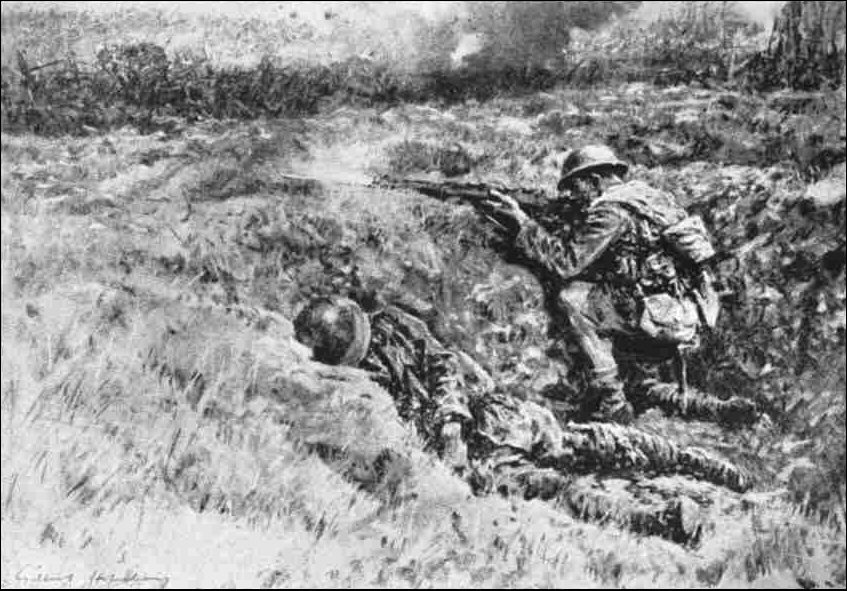
Private Turrall picked up his rifle and opened fire on the bombers, Lieutenant Jennings lay wounded next to him
(Drawing by Gilbert Holiday)
As he worked, a bomb burst close to his head: then another. A German bombing party had seen him moving in the shell-hole. He picked up his rifle and opened fire on the bombers, who were working forward along a hedge. A gap in the hedge enabled him to shoot two of them: the others gave up the attack.
Peering from the shell-hole he saw a wave of German infantry pouring forward from the east—a strong counter-attack. Resistance to such a force was useless, but he did not think of surrender. The subaltern had fainted. Private Turrall flung himself flat and feigned death. He was prodded with bayonets and then left. The counter-attack swept on to break against the Battalion in the village.
Throughout that day he tended and defended the helpless subaltern. When darkness came he cautiously made his way towards the village, with the officer on his back. By good fortune they reached safety.
Private Turrall afterwards stated that his worst moment in the day was when he reached the British line and was hailed in the darkness with "Hands up !" followed by "That man behind you too—quick !" The subaltern was unconscious. He was taller than the private and his feet reached the ground, though his arms were round Private Turrall's neck; but fortunately the position was explained before a shot was fired.
Lieutenant Jennings' wounds proved mortal, and he died within a few hours; but not before he had dictated an account of his soldier's deed; and Private Turrall's brave devotion was rewarded by the Victoria Cross.
In the village itself the last brave remnant of the enemy fought on, holding individual posts for several hours. Those posts were gradually isolated, surrounded and reduced. Strong German counter-attacks were made against the village; but a defensive line had been hastily organised on the
eastern outskirts of the village and the counter-attacks were withered by machine-guns and musketry. By midday the fighting in the village was over : the last German post had been taken, and reorganisation was in progress.
The 10th Worcestershire had reason to be proud of their first battle; for the captured position was of immense strength. The dugouts were so deep and of such solid construction that even after the terrific bombardment of the previous week many of them were still undamaged; and the defenders—troops of the German 13th, 23rd and 110th Reserve Regiments—had fought to the last. The 57th Brigade captured 153 prisoners—nearly all wounded. But the success had been dearly purchased. The Battalion had lost a third of its fighting strength, including the Commanding Officer and Adjutant.
The survivors of the Battalion held on throughout the remainder of the day in such cover as they could find or make, and in the evening the supernumerary officers who had been left behind with the Battalion Transport (This was one of the first occasions on which officers were deliberately left behind before an attack, in order subsequently to replace the inevitable casualties) came up and took over command of the companies. After dark the 10th Worcestershire were relieved by the 7th South Lancashire and withdrew to rest. Orders were to proceed to a trench named "Ryecroft Avenue," but in the darkness the weary troops wandered to and fro for some time before the location of that reserve position could be discovered. Eventually the platoons were housed in crowded dugouts. All next day (July 4th) officers and men slept the sleep of exhaustion, broken at intervals by heavy shelling (One big shell wrecked a dugout, killing five men and wounding two others).
At 9 p.m. on July 4th the 10th Worcestershire moved forward again to the old British front line, in support to the lighting still in progress beyond La Boisselle. Rain and shell-fire made all ranks damp and miserable but the Battalion was not actively engaged. Next morning the Battalion again moved back to the Tara-Usna line. Orders came for the 57th Brigade to be relieved; and after dark that evening the 10th Worcestershire marched right back to billets in Albert.
Tom Turrall wrote to the mother of Lieutenant Jennings' mother giving an account of her son's last hours:
"I hope you will not think me taking a liberty writing to you in this manner but I feel it my duty to do so, as I was with him the whole time and I think you would like to hear the part we played. I must first of all congratulate you in possessing such a plucky son, for he led our company with unflinching pluck that we were not long in taking the enemy's front line.
I might say that when we reached it we came across a dugout held by the Huns. Here your son remarked: "Give me a bomb I will clear them out". He did so. From there we went on to the second line. This proved to be an easy thing for we did not find anyone there, so that made us more enterprising. We were not long before we were in the third line. This is, I am sorry to say, the starting of our hard times, for it was here he received his first wound; a rifle shot in the muscle of the left arm.
Nothing daunted him. He kept on until he received another wound, a bomb this time which caught him in the right thigh. I might say that it was from this time that we found ourselves practically cut off from the remainder of the battalion. It was here that a brother officer advised your son to seek medical aid, but he very pluckily refused, although had he chosen to act as advised I am afraid he could not have done so as we two were now completely cut off. It was advisable to get what cover we could. So we retired to a shell hole some distance in the rear. In doing so your son, I am sorry to say, received two more wounds, one in the right knee, and the other shattered his left leg a little below the knee. As we could get no further I did all I could for him, using my entrenching tool handle and bayonet scabbard as splints, and my puttees as bandages. It is hard to tell you that we were obliged to remain like this for something like three and a half to four hours before I at last carried him in.
How he bore his pain was surprising, for he continually chatted and smoked with me until I at last managed to get him to the dressing station. It was here that we parted, but not without him thanking me for the part I played. I am sure in the success of the Worcesters at (blanked by censor) your son played a very prominent part although badly handicapped by his wounds. Hoping this little but thrilling account will afford you some small consolation in your great loss and at the same time tending mine and all his comrades' sympathy".
Tom Turrall with his daughter going to collect his V.C. at Buckingham Palace |
Tom Turrall finally went to receive his VC from King George V at Buckingham Palace on the 1st January 1917. He took his young daughter and his parents with him (seen here in the adjacent photo). In common with many other VC awardees he was commemorated on a cigarette card, part of a series produced by Gallahers. His home address now was with his parents at 23 Oakley Road in Small Heath. Turrall returned to the front-line and fought on with the 10th Battalion Worcesters until the armistice. He was finally demobilised in April 1919 and returned to Birmingham to resume his painting and decorating work at the Council. Prior to his return it was announced on 24th February 1919 in the local Birmingham press that a committee had been formed in Small Heath for the purpose of making a presentation to Turrall in recognition of his achievements. It was mentioned that all of the Birmingham MPs and City Council members were to be asked to assist. After the loss of his first wife Turrall remarried, this time to Daisy May Davis in 1920 in Aston. Throughout the rest of his life he was a keen attender of military reunions in Worcester and was much to the fore on parades and ceremonies. |
Gallahers cigarette card |
After the war in common with many other V.C. awardees he was commemorated on a cigarette card, part of a series produced by Gallahers. After attending HM Queen Elizabeth II Garden Party in the grounds of Buckingham Palace for holders of the VC on the 17th July 1962, in October of that year he decided to sell his VC medal group as he thought he was too old to attend future ceremonies at which he would wear his V.C. He thought the money from they sale would help him to eke out his pension. When the Birminham Branch of the Worcestershire Regiment Association heard about this they persuaded him not to sell and approached the Regimental H.Q. at Norton Barracks, Worcester who raised the money to buy the medal group after an appeal to past and present members of the Regiment. The Regiment decided to buy the medal group for £500 but agreed that Tom Turrall would keep the medals until he died, after which they would go to then go to Regimental Museum.
|
Tom Turrall and his wife Daisy (1961) |
Brigadier D. H. Nott and Tom Turrall V.C (8th April 1961) |
Tom Turrall
in 1964 just before his death |
Tom Turrall died suddenly aged 78 on the 21st February 1964 in Selly Oak Hospital, Birmingham. Although he was obviously ill it still came as a great surprise. Only two days before his death he had been visited by Lieutenant-Colonel C. P. Vaughan and Lieutenant-Colonel J. D. Ricketts from the Worcestershire Regiment Headquarters. The two men had found him to be in good spirts and there seemed no reason to expect his untimely death. The funeral was held at Robin Hood Cemetery on 28th February.
Local resident named Len Copsey cleans and tends the grave |
Thomas George Turrall V.C. gravestone at Robin Hood Cemetery, Solihull His grave can be found in section A-4 North, grave 193. Coming up the main drive towards the Chapel, A4 North lies halfway up on the right hand side. The headstone reads: "In honoured memory of T.G. Turrall V.C., the Worcestershire Regiment, 5th July 1885 21st Feb 1964, erected by the regiment".
(photo provided by Mark Rogers) |
Thomas George Turrall V.C. medal group |
Medal Group Victoria Cross
|

